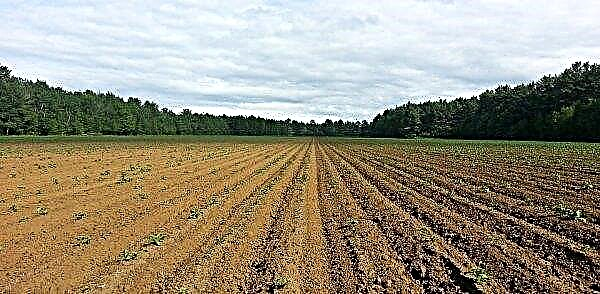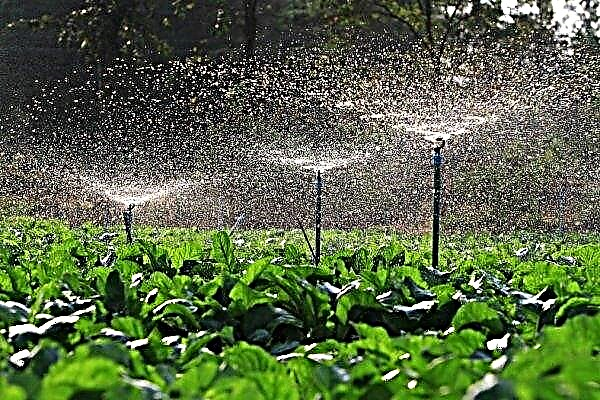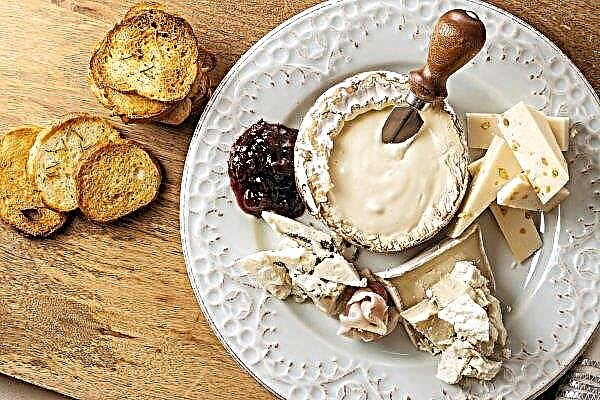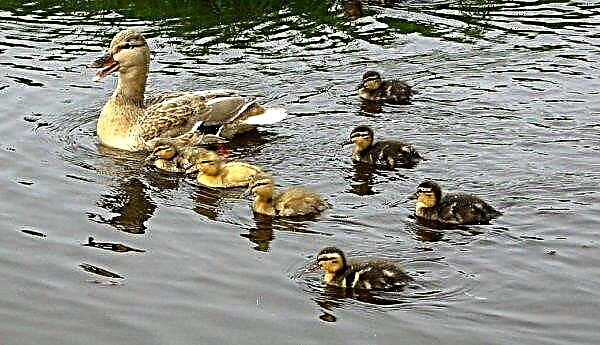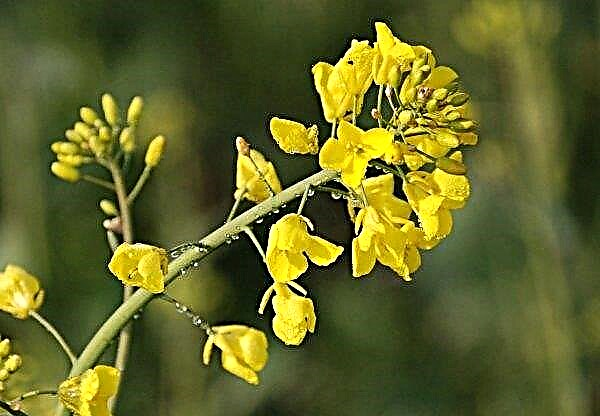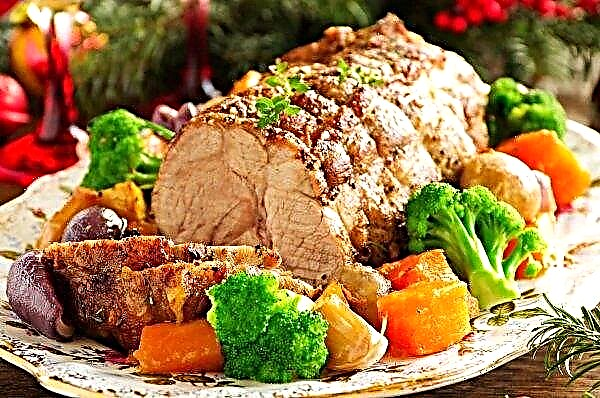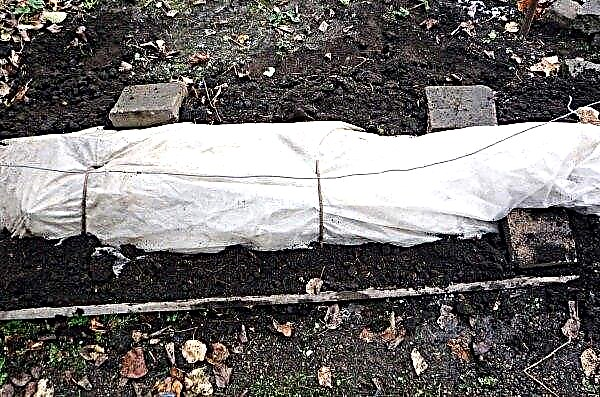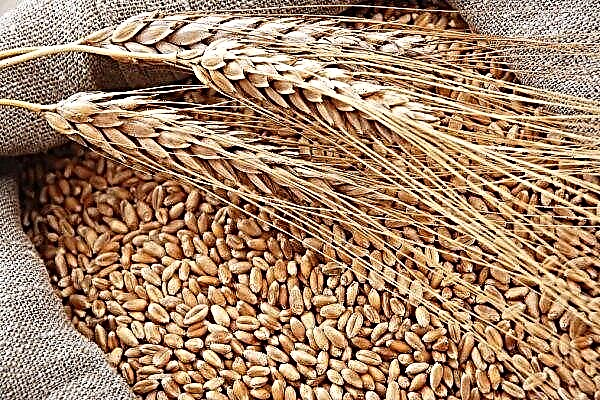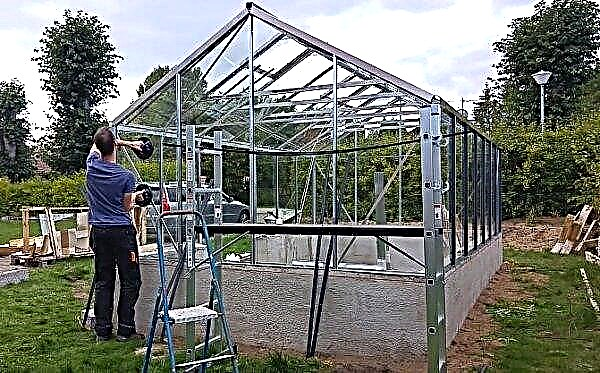Common carp (or common carp) lives in fresh water bodies and rivers located in a strip with a temperate climate. In addition, fish are often bred in suburban areas, equipping it with an artificial pond or pool. Common carp is unpretentious to the conditions of detention and can eat various food, but for normal growth, certain rules must be observed when growing it. The main recommendations for the breeding of this fish, a description of the characteristics of its spawning and feeding - further in the article.
Features of carp spawning
Carp begins to spawn in the spring after the establishment of stable warm weather. This process is carried out once a year and usually falls in the second half of May, ending around mid-June. After spawning, the process of formation and bearing of sexual products in sexually mature individuals lasts for a year.
Important! Visually distinguishing females of carp from males is possible only during spawning. At the same time, the abdomen in female individuals increases, the genital opening becomes reddish and swollen, and in males, when pressed, milk is released.
The main features of spawning:
- common carp reaches puberty at the age of 3-4 years;
- first, small individuals spawn, and then larger ones;
- during spawning, the water temperature should be at least + 18 ° C;
- the female throws eggs in stages over several days, but the first portion is the largest;
- after laying eggs, males immediately fertilize it with milk, spreading them within a radius of several meters;
- during the onset of cooling, spawning is suspended, and the fish is waiting for the onset of favorable conditions;
- the most active spawning and fertilization occurs from dawn to noon;
- females prefer to lay eggs in shallow water, choosing the same places for this;
- spawning individuals lie on rest for 5–7 days, becoming inactive, and then restore strength by enhanced nutrition.
 When breeding carp at home for spawning, it is recommended that they be transplanted into a separate pond. At the same time, each female should have 1-2 males.
When breeding carp at home for spawning, it is recommended that they be transplanted into a separate pond. At the same time, each female should have 1-2 males.
A layer of moss or turf is laid at the bottom of the reservoir - it is in it that the fish will spawn. Approximately one week after fertilization, the eggs hatch and the young appear. So that the fry are not eaten by adults, the latter are transplanted back into the main body of water. Young offspring must grow in a separate pond.
Growing carp in the home
If you wish, you can independently engage in the breeding of common carp at home, growing it in an artificial reservoir. This process is quite simple, as the fish grows quickly, is characterized by unpretentiousness to the conditions of detention and the composition of the feed. But before you buy fry, you need to prepare a place for their cultivation and purchase the necessary equipment.
Did you know? In the natural environment, the carp is hibernated for the winter. When the temperature drops, it sinks to the bottom of the pit and does not wake up until spring.
Seat selection
To obtain the desired result, first of all, it is necessary to choose and prepare the place for fish growing.
Basic requirements for the location of the reservoir:
- one part should be in the sun, and the second in the shade - the carp is thermophilic, so the water should warm up well, but in extreme heat the fish will be more comfortable in the shade;
- Keep away from noise sources. - loud extraneous sounds will frighten the fish;
- pond cannot be equiped in a lowland - in this case, during rains, dirty water will flow into it.
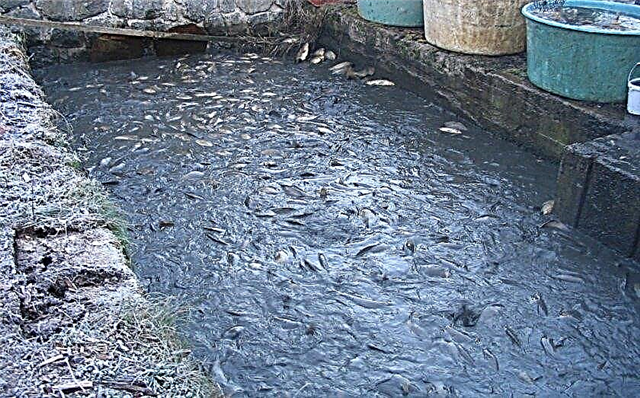
Pond
In private fisheries, an artificial pond is usually used to breed carp. In order for the fish to grow normally in it and not suffer from diseases, you need to follow some recommendations. The preparation of such a reservoir usually takes about one year.
Basic requirements for the arrangement of an artificial pond:
- the depth of the reservoir can be from 1.5 to 3 m - if this parameter is greater, then the sun will not be able to warm the water column well;
- the fish need a sufficient amount of free space, so the length and width of the pond should be about 3 m;
- so that the soil from the shore does not slip into the water, it must be strengthened - for this, trees and shrubs are planted near the pond;
- before pouring water, it is necessary to compact the bottom of the pond - it is covered with sand and poured with liquid concrete mixture, and when the latter dries up, stretch a rubber film on top;
- to create a natural microclimate, 20-30 l of water from a wild lake or river is poured into an artificial pond - it contains the necessary microorganisms;
- you can additionally sow the bottom of the pond with algae - they contribute to the creation of natural microflora, and also serve as food for carp;
- Before starting the fish, the water in the reservoir should stand and warm up to a temperature of + 24 ° С.
Important! If harmful microbes appear in the pond, then the carp can get sick. The main source of pathogenic microflora are birds, so they should not be allowed into the pond.
Pool
It is also possible to grow carp on a site in a specially equipped pool. In such a reservoir it is easier to monitor the purity and temperature of the water, and it is also possible to observe the behavior of the fish.
Basic rules for preparing the pool:
- you can dig such a reservoir in the ground or use ready-made store constructions made of plastic, polypropylene;
- the depth of the pool should be about 1.5 m, so that the water is well warmed up by the sun;
- the reservoir can have a round or square shape, and its width should be 2-3 m, so that the fish had enough free space;
- for the convenience of changing the water, a drainage system is equipped - a hole is placed at the bottom of the structure, connecting a pipe to it with a plug at the end leading to the sewer;
- to create natural microflora, several buckets of water from a wild fresh lake or river are added to a reservoir;
- the filled pool is left to settle for several days to warm the water and multiply the necessary microorganisms.
Video: Carp pool device
Breeding equipment
When breeding carp in an artificial pond, it is recommended to use additional equipment that will facilitate the care of the fish.
The list of such devices include:
- cages for catching fish;
- filters on water supply and drain pipes - do not allow the carp to slip into the holes;
- compressor or aeration system - needed to enrich water with oxygen;
- car feeders - allow you to give the carp food several times a day at certain intervals;
- oximeter - determines the level of oxygen in the water;
- pumps - facilitate the pumping of water in a reservoir;
- incubators - provide ideal conditions for the successful removal of fry from fertilized eggs;
- thermometers - allow you to determine the temperature of the water;
- equipment for artificial heating - used when wintering fish outdoors, allowing you to maintain a comfortable temperature in a pond or pool;
- bottom cleaners - help maintain the cleanliness of the reservoir without frequent water changes;
- sterilizer - kills harmful microflora;
- devices for checking the composition of water - allow you to control the degree of contamination of the reservoir and clean it in time.
Did you know? Carp has excellent hearing. Hearing a loud sound or an unpleasant creak, the fish immediately goes to great depths.
Suitable conditions
Common carp belongs to unpretentious fish, but it grows and multiplies best when certain conditions are created in an artificial reservoir. First of all, heat-loving carp needs water of a comfortable temperature, which contains a sufficient amount of oxygen. In addition, you need to monitor the cleanliness of the reservoir, since its excessive pollution leads to the appearance of harmful microorganisms and fish diseases.
Temperature
For the active growth of fish, it is necessary to maintain a certain temperature in the reservoir. In summer, carp is grown in a pond or outdoor pool. The optimum water temperature is + 22 ... + 24 ° C. In hot weather, an artificial pond can become very hot in the sun. But water temperature should not exceed + 30 ° Сotherwise, the carp will eat poorly and grow slowly.
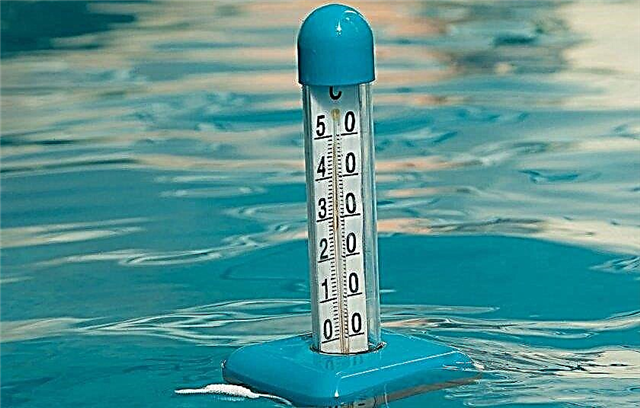 Special thermometers are used to measure water temperature.
Special thermometers are used to measure water temperature.
Regulation of thermal processes in a reservoir is carried out by adding or draining water. For winter, carp is recommended to be moved to a large indoor aquarium. You can leave them wintering in the open air only if the pond is equipped with an aeration system and the positive temperature is constantly maintained in it due to the artificial heating of the water.
Water and its oxygen content
The ideal environment for growing carp in an artificial pond is to simulate a small flow and a sufficient level of oxygen. This effect can be achieved if you create a moderate movement of liquid in a pond or pool, and also use special devices to enrich it with air bubbles.
Important! To fill a reservoir with carp, you can not use water from a central water supply. It undergoes chlorination and contains a lot of salts, so it is completely unsuitable for fish.
Basic requirements for water in a pond for growing carp:
- clean water is supplied from a river or a well through a narrow pipe equipped with a pump;
- dirty liquid is drained into the sewer - this procedure is carried out through a wide pipe with a filter located at the bottom of the pool or pond;
- the oxygen content in the pond should be at least 3 mg / l - this parameter is measured using an oximeter;
- in order to increase the number of air bubbles in the water, a compressor or a special oxygen generator is installed on the bottom of the pond or pool.
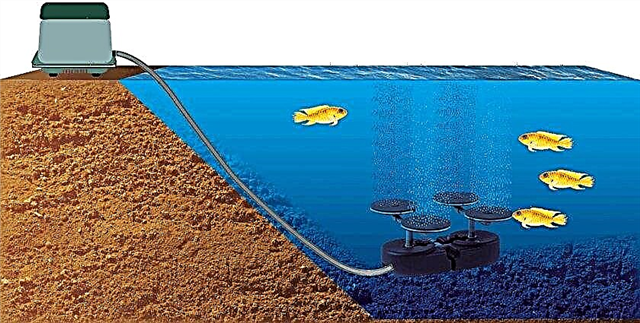
How to breed
After preparing the artificial pond, you can start breeding carp at home. To do this, procure young individuals, which are launched into a prepared pond and pool. After performing these procedures, it is necessary to monitor the maintenance in the reservoir of optimal conditions for the growth and development of fry, and also to know how much food is required for individuals.
Purchase of fry
There are many varieties of carp, living in areas with different climate conditions. When buying young animals, it is recommended to take the type of fish that is suitable for growing in a particular region.
Basic rules for the purchase of fry:
- It is recommended to purchase young animals at a specialized fish farm that has the necessary certificates and licenses;
- fish should be transported in spacious tanks or buckets with fresh or rain water;
- fry for sale must be kept in a clean reservoir that meets all of the above requirements - otherwise there is a risk of buying sick and weak individuals;
- the optimal age of the young is one year.

When to run
So that the fry were comfortable in the artificial pond and they did not die, the water should warm up well to a temperature of + 22 ... + 24 ° С. Experienced owners of fisheries recommend running carp in a pond or pool in the interval from late April to early May. The choice of a specific date for this procedure depends on the climatic conditions of the growing region.
If the reservoir by this time remains cold, then special equipment is used to heat the water. When growing carp in the southern regions, it is allowed to carry out stocking in early autumn. But in this case, the fish may not have enough time to grow stronger and grow before the onset of cold weather, so it is recommended to move it to a large indoor aquarium for the winter.
Did you know? Pheasant belongs to one of the most dangerous invasive species. In the Murray River, flowing in Australia, the number of this fish exceeds 80% of the total mass of living things.
How and what to feed
In order for the carp to show a fast growth rate, it needs a balanced diet. The feed should contain all the substances necessary for the fish and be served without interruption, in equal portions.
There are such types of feeding carp:
- Extensive. Individuals find their own food in an equipped pond, inhabited by natural flora and fauna (with the exception of other fish species). With this kind of feeding, the carp is slowly gaining weight, but its meat is an environmentally friendly product.
- Intensive. Fish are given a special feed containing about 30–40% protein, which stimulates rapid growth and contributes to weight gain. But at the same time, the taste characteristics of meat deteriorate, and the reservoir is often contaminated with food residues.
- Semi-intensive. Combines the first two types of feeding and is the most rational when growing carp at home. In this case, the fish partially eats on their own, but also receives complementary foods.
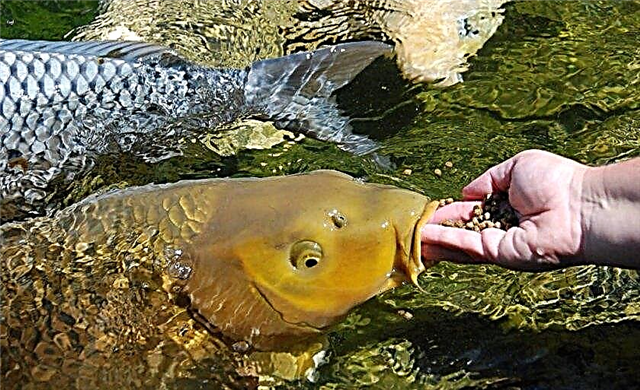
When feeding a carp, they adhere to such general recommendations:
- fish actively feeds only in warm water;
- feed fall asleep in the morning and evening before sunset;
- the feeder is installed in a specific place in the reservoir and try not to move it;
- legumes and grains (wheat, beans, corn, oats, peas), earthworms, maggots, bloodworms, as well as ordinary rye bread are used as complementary foods;
- the food is covered in small portions - in this case, the carp can completely eat it, and the remaining food will not pollute the water in the pond or pool;
- a single feed rate is approximately 3% of the weight of the fish;
- so that the fish develops normally and does not hurt, special feed for chickens and pigs must be added to the diet, using it according to the instructions on the package.
To what maximum sizes it grows
Common carp lives about 30 years, and individual individuals can reach the age of 40 years. The rate of weight gain depends on the growing conditions of the fish and the regularity of its feeding. An adult can weigh more than 25 kg, with a maximum length of 1.2 m. At home, carp is usually grown to sizes 40–45 cm.
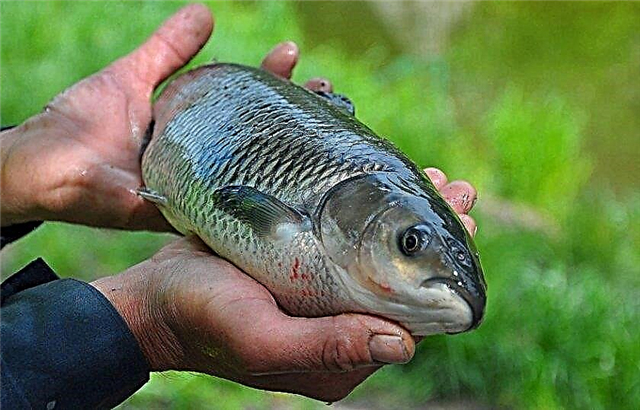
An approximate ratio between the weight of an individual and its length is presented in the table:
| Length | Weight |
| 10 cm | 25-30 g |
| 20 cm | 200 g |
| 25 cm | 350 g |
| 30 cm | 420 g |
| 35 cm | 550 g |
| 40–45 cm | 900 g |
| 50–70 cm | 4-5 kg |
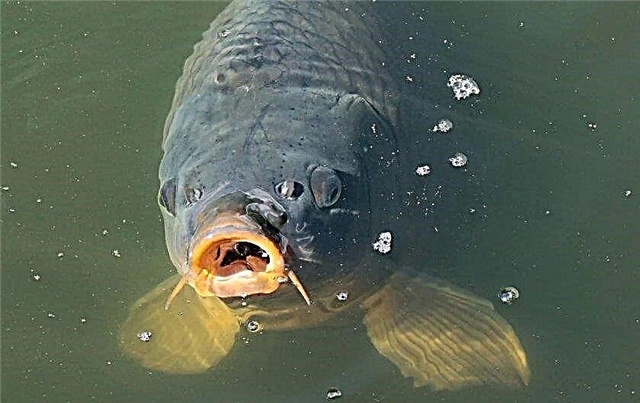 Growing carp in an artificial reservoir in the country, you can not only provide yourself with fresh fish, but also to establish its sale.
Growing carp in an artificial reservoir in the country, you can not only provide yourself with fresh fish, but also to establish its sale.
The information presented in the article will help you choose and prepare a place for fish farming, provide it with the necessary care for active growth, as well as properly feed carp, in order to get environmentally friendly meat with excellent taste characteristics.


